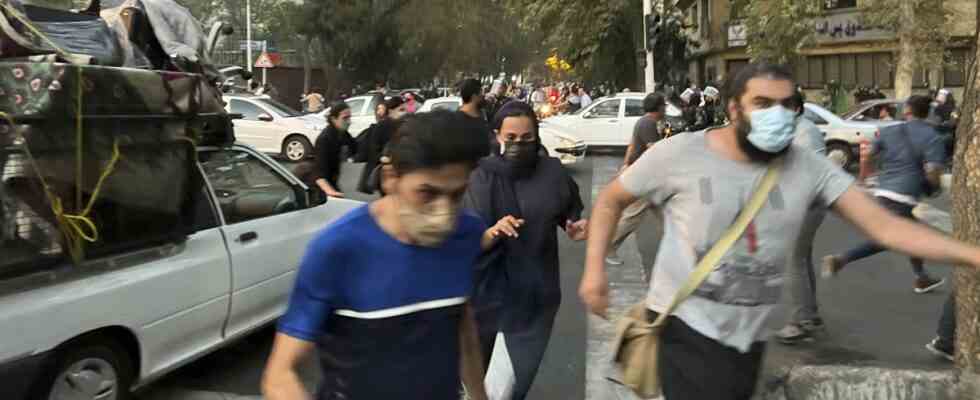As the unrest in Iran continues after 11 days, the protests are gaining increasing support from celebrities. Faezeh Hashemi, the daughter of late ex-President Ali Akbar Hashemi Rafsanjani, has been arrested in Tehran. She called for support for the protests that broke out after the death of 22-year-old Mahsa Jina Amini, who was arrested by the religious police. The two Oscar-winning, internationally renowned Iranian filmmaker Asghar Farhadi, other actors and internationally renowned soccer players also joined the demonstrations of solidarity.
The regime news agency Tasnim wrote that Faezeh Hashemi was arrested for “inciting riots” because she publicly supported the protests. The 59-year-old Hashemi, a former MP and sports official, wears a headscarf and is also known as a harsh critic of the Islamic Republic’s theocratic regime. Her father, an ex-president, was one of the co-founders of the Islamic Republic; he was one of the most influential politicians and entrepreneurs in the country for decades.
Director Farhadi said he was proud of the protesting women. He explained via Instagram that the demonstrating women were demanding “simple but fundamental rights that the state has been denying them for years”. Other celebrities, including well-known television and series actresses, also backed the protest movement that formed after the death of the Kurdish-born Amini. “I am an Iranian who has worn veils for years because of coercion and fear,” actress Shiva Ebrahimi explained. “I never did that voluntarily, and I never will.”
More than 70 people are said to have died in the protests
The now nationwide protests broke out because Mahsa Jina Amini was arrested by the religious police in Tehran because of an allegedly incorrectly fitting headscarf and died in hospital three days later – apparently from a severe skull injury as a result of abuse. The police and the notorious Basij militiamen are now taking more and more ruthless action against the protesters. So far, more than 70 people are said to have died in the demonstrations, including members of the security forces.
But what is really going on can hardly be judged by outsiders because the authorities are throttling down the Internet and mobile communications and foreign journalists are currently not coming to the country. The protests are geared towards what is still getting out through social media, and no longer just against the headscarf requirement and the strict dress code for women. Many demonstrators are increasingly demanding comprehensive freedoms and even the end of the Islamic Republic.
According to experts and those familiar with the country, it is not yet possible to say whether these protests really endanger the theocratic regime. Like in previous protests, the regime, which is headed by 83-year-old Ayatollah Ali Khamenei as spiritual leader, will most likely not shy away from rampant violence, deploying its hundreds of thousands of police, special forces and basijis. All protests had been suppressed in the past. In addition, the current demonstrations do not seem to have the number of participants as, for example, the nationwide protests of 2009. These, too, were bloodily suppressed.
Iran is increasingly turning into a militarized system
The Islamic Republic is a system of government that is unique in the world. Founded after the Islamic Revolution of 1979 and the associated overthrow of the monarchy under Shah Reza Pahlavi, it relies on the Koran and the associated Islamic principles as the basis for state action. It goes back to the then revolutionary leader Ayatollah Ruhollah Khomeini. The Shiite cleric lived as a dissident in Iraq, Turkey and France during the monarchy. He had essentially developed the model of an Islamic republic and after the fall of the monarchy also became the first spiritual leader.
His regime will probably not shy away from rampant violence: Ayatollah Ali Khamenei, Iran’s supreme leader, in Tehran last week.
(Photo by Office of the Supreme Leader of Iran/IMAGO/ZUMA Wire)
The Islamic Republic does not have a real separation of powers as in democratic systems of government. Even if there is a president and an elected parliament in Iran, the spiritual leader is above all. He is considered to be the representative of the Mahdi, a Shia redeemer figure who is to appear on Judgment Day. The theocratic system is therefore only partially controlled by the elected parliament and the president elected by the people. In addition to the “Spiritual Leader”, several expert committees made up of theologians and Islamic lawyers are also involved in decisive questions. One of the committees also elects the new spiritual leader.
However, Iran has long ceased to be a real “mullah republic” – the republic is increasingly turning into a militarized system. The Revolutionary Guards created by Ayatollah Khomeini play a key role in both foreign and domestic policy and control large parts of the economy. The protesters in the streets therefore not only have to fear resistance from theologians. Equally dangerous are those in uniform, who would have to fear for their benefices in the event of a regime change or even resolute reforms.

